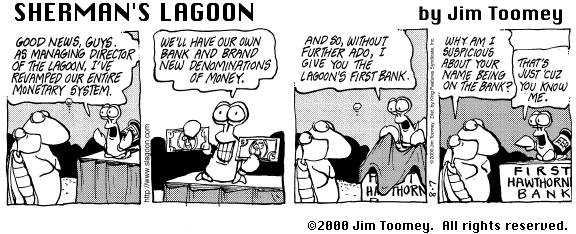

Reproduced by permission of the artist.
Talk with anyone in the United States who knows about local currency, and within ten minutes the name Paul Glover will come up in conversation. Described as a miracle worker, tireless activist, and even a P. T. Barnum, Glover's name is synonymous with local currencies in communities across the nation. The general-use currency he helped begin in upstate New York, Ithaca HOURs, has had a vibrant history, spawning a host of imitators and followers across the United States and Canada, and attracting media attention from as far away as Japan.
Program History and Design
Having first run for Ithaca City Council in 1973 as an environmentalist candidate, Glover has a long history of involvement in social causes and local community. He fought against four-lane highways running through town, and then moved to Boston, from which he decided to walk to San Diego. After several years in California, he returned to Ithaca and ran a LETS for two years. Glover's continued interest in self-sustainability led him to study community economics for two years with a grant from the Fund for Investigative Journalism. During this time he learned about Berkshire notes and studied community economics and regional scrip before designing and promoting a similar model within Ithaca. Unemployment was high in Tompkins County in 1991 during the recession that followed the Persian Gulf conflict, and people were willing to try new things. First to sign up was a local massage therapist, who probably never suspected that his profession would become the occupation most mentioned in association with local currencies in the future; a songwriter/musician and a writer and cook were the next to follow. Glover signed up other community members and arranged for the currency to be printed, becoming consumed by the details of the project. The day after he issued the currency, his girlfriend left him, which he wryly explains by saying, "I had just married a money system."1
Two years into the project, Glover was offered a post with AmeriCorps to continue working on Ithaca HOURs, which ended up giving him a steady, if small, stream of income for over three years which he used in part to help pay expenses of the Ithaca HOUR system.2 As the program grew in size and public prominence, he began deriving supplemental income from selling a "starter kit" containing a set of plans and ideas for beginning local currency programs, and details of the success and methodology behind Ithaca's program. To this date, over 500 reports in print and broadcast media have covered this phenomenon.3
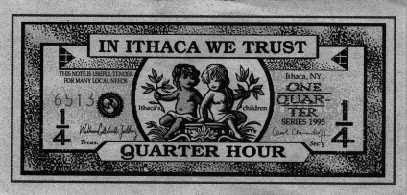
Figure 9. Face of quarter HOUR note from Ithaca, New York, 1995.
Glover denominated currency in HOURs, explaining that, "Everyone's honest hour of labor has the same dignity."4 Believing that equality of dignity should display itself in equality of outcome, he sought to psycholinguistically reinforce this in the collective subconscious of the community. By denominating currency in time units, Glover hopes to reinforce a connection between money and the effort required to earn it, and establish equivalencies between money and that source. This is far from new; the shekel, Israel's current monetary unit, means "bushel of wheat."5 Though exchange is not required to be at the rate of one HOUR per hour of labour, Glover intends to encourage his vision of income equality through the currency he propagates.
Ithaca HOURs circulate throughout Tomkins County, New York, and are valued at $10 per HOUR, since $10 was calculated to be the average county wage. There is no currency board freely trading dollars for HOURs, but those who want to hold more HOURs and fewer dollars can exchange dollars for HOURs at face value at several local businesses that do steady business in HOURs. To reduce holdings of HOURs, however, one must either find a friend who wishes to hold HOURs or else spend them in the community.
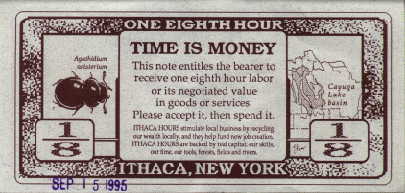
Figure 10. Reverse of eighth HOUR note from Ithaca, New York, 1995.
The currency is put into circulation via several methods. As incentive for joining, four HOURs were given initially to each individual who agrees to accept HOURs in trade; that has been decreased to one HOUR due to the success of the program. This suggests that HOURs have risen in value since their inception as the base of goods and services backing them, measured by the number and variety of individuals and businesses accepting HOURs, has grown from an initial 90 members to its present state with over 1500 listings in the bimonthly newsletter HOUR Town. HOURs are also given out when individuals renew their annual membership, and as loans to businesses and grants to community organisations. In addition, up to 5% of HOURs issued are reserved to pay system expenses, such as printing the newsletter, office supplies, and various publicity-related costs.6
Members list services they provide or desire in HOUR Town, a newsletter and directory published quarterly. This informs members and non-members alike of many opportunities for exchange. HOUR Town is distributed to a variety of locations across Tompkins County and currently pays for itself by selling advertisements. Ithaca Money, the non-profit corporation overseeing Ithaca HOURs, also distributes signs for businesses to display in their store windows to proudly declare that they accept HOURs. This reduces the information cost to users of finding places to spend their local currency, and may further serve to signal that the business owner in question values the community enough to support a potentially risky local venture, thus encouraging reciprocity in the form of increased local business.
There is no central bank conducting market operations; rather, a Circulation Committee meets monthly to decide the quantity of new HOURs to issue. Glover defines inflation as "the perception by any participant that they have more HOURs than they can readily spend."7 He is not concerned about inflation in Ithaca, believing that demand is still greater than supply, at least by his definition of terms.
If demand is to be said greater than supply, this can only make sense in an economic framework when considering quantities supplied and demanded at a current price level and not the total supply and demand functions. A traditional market solution to this disparity would be to allow the price of HOURs to rise from $10 per HOUR to some equilibrium point. Given the Ithaca HOUR's small magnitude of issue and the costs of updating every merchant daily or weekly on price fluctuations for merchandise pricing and tax reporting purposes, this would likely cause the death of the HOURs program, or at least would add so heavy a burden to those choosing to exchange HOURs as to greatly decrease both their demand and supply.


Figure 11. Glover's description of supply and demand (top) and the author's view (bottom)
Glover claims that demand outstrips supply at the current price. This suggests that $10 should be viewed as a price ceiling. By his design, it is also a price floor. But since the level of currency in circulation is decided not by market forces but by committee decision, the money supply is fixed. This then would suggest that Ithaca Money is running an inefficient program by attempting to fix both price and quantity; in a traditional analysis one can only force one or the other, though one may attempt to encourage the second simultaneously. The left-most graph in Figure 9 shows supply as fixed in quantity in order that quantity demanded is greater than the quantity supplied at the price which Glover seeks to encourage individuals to value Ithaca HOURs.
If, as Glover says, demand is greater than supply, Ithaca Money ought to either increase supply to provide HOURs more abundantly or permit the price to rise to the benefit of those who were already trading in HOURs and benefit of those seeking to get their hands on scarce HOURs. The price ceiling is not fully maintained, however, as Ithaca Money sells HOURs to collectors at prices up to ten times the face value.8
In actuality, I suspect the supply curve is kinked, and that the relevant portion of the supply curve is horizontal, with HOURs available at a fixed price of $10 per HOUR; demand by collectors can be considered a second and completely independent market given their specific demands concerning the appearance of the HOURs they purchase. All but the most fervent of HOURs users still use federal currency as their dominant money and most have probably not made plans to change to using HOURs for the majority of their purchases. Since Ithaca Money has not placed into circulation all the bills it has printed, but will permit visitors to purchase it at face value, the system's capacity to supply HOURs is greater than the current quantity demanded. The system in fact is in equilibrium. Demand is not greater than supply. Only when total demand for HOURs is not satisfied by the available supply of HOURs at the current price will demand exceed supply, and this will easily be rectified if price is allowed to rise.
Nine Benefits of HOURs
Glover claims there are nine major benefits to a local currency system like HOURs.9 Given the variety of dimensions which HOURs purports to affect, a traditional economic analysis may not be the best of evaluators for all of these. Attempts to measure the value of increased community cohesiveness or import substitution from a theoretical standpoint are extremely difficult and require numerous assumptions about the proper design of such a model. Absent extensive practical data, a final declaration of a program's success or failure with regard to its stated objectives may not be possible. We can make reasonable statements about the probability of achieving some objectives, and the likely longevity of the currency's operation, but when it comes to vague idealistic objectives such as "reinforcing social and environmental ethics of responsibility, equity, mutual self-help and community development,"10 any proposed measurement technique must be carefully scrutinised for the ease of which subjective biases may be introduced and the likely pseudo-scientific quantification of variables traditionally considered to be qualitative. Nonetheless, it seems fair to begin by providing an evaluation of the success of Ithaca HOURs against its own standards before turning to outside analysis techniques and an examination of the programs it has spawned. Since Glover's intended meaning for some of these is not perfectly clear, a detailed economic analysis may be merely pouring ink down the drain, but a brief discussion seems clearly relevant. Some of Glover's nine claims are true, some are false, and others are not provable with the information available at the time of this writing.
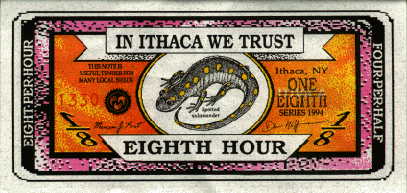
Figure 12. Face of eighth HOUR note from Ithaca, New York, 1995.
Glover says "HOURs expand the local money supply." This is not provable; HOURs indeed are a local money, of no value outside Tompkins County except to the aforementioned collectors, and therefore to the extent that they are issued, they are expected to circulate locally. However, it is possible that they will not add to, but instead replace, federal currency in local circulation. To the extent that HOURs crowd out federal dollars from the marketplace, HOURs do not expand the money supply.
HOURs supposedly "promote and expand local shopping, with an endless multiplier." The truth of the first part is dependent upon how HOURs are used; the second is either false or meaningless. If the presence of HOURs in one's wallet causes one to conscientiously choose to buy locally when one would have acted otherwise, this is true. If, however, local shopping purchases that would previously have been made with federal currency are now made with HOURs, nothing has changed except the paper changing hands. Glover has said nothing about local currency that is not true of federal currency if by an endless multiplier, he means that the currency can be used over and over to purchase things. From an economics standpoint, where the money multiplier is the value of trade generated by or undertaken with a certain quantity of money in a given period of time, the concept of an endless multiplier is certainly false. Former International Monetary Fund executive and current Ithaca HOURs board member Monica Hargraves has written that the annual money multiplier for HOURs has been estimated at six, a much smaller number than endless.11
HOURs are said to "double the local minimum wage to $10.00, benefitting not only workers but businesses as well, who find new and loyal customers." This long phrase sounds attractive and contains numerous parts mixed together but is overall false. Whether a raise in the minimum wage is beneficial is a discussion that has raged on in many circles and I will not presume to possess the answer there. How paying more per hour for an employee's time is beneficial to the business employing them, I cannot see unless it is by some indirect element that is probably outweighed by the forced increase in expenses. If the productivity of employees had been worth less than $10 per hour and will now increase because they are paid more, there is no reason to suspect that businesses could have increased their productivity by paying them more before HOURs came along. Though the reality of these two elements are unclear, there is a clear fallacy in saying that HOURs double the local minimum wage. HOURs makes no requirement that users pay one another at any rate whatsoever. Though Glover would like to encourage payment of one HOUR for one hour of labour, HOURs do not move the minimum wage; individuals choose to pay more if they wish.
HOURs are falsely claimed to "enable shoppers to afford premium prices for locally-crafted goods and for locally-grown organic food." The only way one can afford higher prices for local goods as a result of the type of money in one's wallet is if one is "stuck" with it and has nothing to spend it on save expensive local goods. In such a case, where there are no alternative uses for the currency, purchasing at premium prices becomes just a way of life. Glover also does not mention what E. F. Schumacher Society executive director Susan Witt describes as the value of these locally-crafted goods:
By intentionally narrowing our choices of consumer goods to those locally made, local currencies allow us to know more fully the stories of items purchased - stories that include the human beings who made them and the minerals, rivers, plants, and animals that were used to form them.12
The consumer may choose to value purchasing locally-produced goods, but this does not make them more affordable, merely possibly more valuable. In such a case, since the value to the buyer has risen, he may be willing to pay a higher price, but this increased willingness to pay in no way increases the amount of money in his wallet. Premium prices for local goods are no more affordable with HOURs, just perhaps more tolerable. Further, a distinction must be always kept between locally-purchased and locally-produced, as it can reasonably be postulated that most individuals make most of their purchases within a twenty-mile radius from their place of residence, but many of those goods are imported from outside the region.
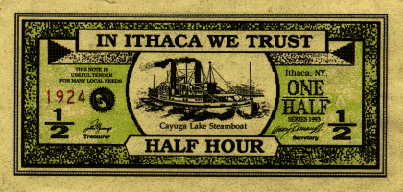
Figure 13. Face of half HOUR note from Ithaca, New York, 1993.
HOURs are said to "help start new businesses and jobs," for which proof anecdotal evidence must be introduced. Glover writes that HOURs "have made millions of dollars value of trades representing hundreds of job-equivalents at $20,000 each."13 Aside from the previously-mentioned issue that HOURs may merely have replaced federal currency in many of those transactions, the success stories Glover has posted on-line do not suggest that new full-time jobs have been created.14 However, by counting home businesses and supplemental part-time jobs, Glover can claim to have been an agent in job creation. That HOURs as a local currency caused the jobs to be created any more than would be accomplished by a series of pep talks about entrepreneurship and resourcefulness has yet to be shown.
Appealing to the conservationist, HOURs are claimed to "reduce dependence on imports and transport fuels." HOURs by themselves do nothing to cause this. Dependence on these is only reduced by the decision to seek out locally-produced goods, which process is not forced on the consumer in any way, shape, or form by HOURs. They can incidentally encourage it insofar as HOURs will be used by merchants to pay local expenses. If merchants can make locally-produced goods available for HOURs but require federal currency for imported goods, then local currency can serve as a self-imposed barrier to inter-regional trade by only being accepted in certain locations, something for which one store owner found no value:
I think it creates a lot more restriction that currency is supposed to eliminate. . . . We're doing as much as we can to support local businesses anyway, so I don't feel that I need to do this. We try to do it as a philosophy rather than, "This is what I've got, so I guess I'll..."15
As he notes, the decision to support local business does not need a local currency. Additionally, a local currency may be accepted as partial payment for imported goods insofar as the local currency is used to pay the seller's profit margin or salary. In such cases, a local currency will not decrease dependence on imports.
Glover says that HOURs "make grants to nonprofit community organizations" and "make zero-interest loans." These two are clearly true, being decisions of the non-profit organisation which oversees Ithaca HOURs. Any other group could conceivably do the same if they desired to do so. The incentive for using HOURs is therefore one of supporting an organisation with values in which one believes.
The last benefit attributed to HOURs is that they "stimulate community pride." From the listing of success stories in the HOUR Town newsletter and on-line, it is clear that those who choose to participate have a lot of pride in their community. Whether they possessed as much pride before they joined HOURs is unclear, as is the question of what function is performed by the HOURs program to increase pride. Nonetheless, it is reasonable to say that community pride has probably increased as a result of the HOURs program.
Successfully performing several of its stated benefits but not accomplishing several others, the Ithaca HOURs program is a mixed bag by its own standards. Nonetheless, it has inspired numerous imitators. Due to different circumstances surrounding their origin and implementation, they have had varying levels of success. It is this aspect, the success of Ithaca's imitators, that is the next subject of study.
| Contents | Previous Chapter | Next Chapter |
Endnotes:
1 Paul Glover, "A History of Ithaca HOURs," Ithaca HOURs, January 2000. Available [Online]: <http://www.lightlink.com/hours/ithacahours/archive/0001.html> [21 September 2000]; Susan Witt, "Printing Money, Making Change," Orion Afield, Autumn 1998, 19.
2 The capitalisation of HOURs varies from writer to writer, it seems. Some write HOURS, and others write Hours. Since the singular unit of currency is the HOUR, I have chosen to write its plural always as HOURs.
4 Paul Glover, Hometown Money (Ithaca, N.Y.: Ithaca Money, 1995).
5Bernard Lietaer, The Future of Money (London: Random House, 2001), p. 34.
6 HOUR Town (Ithaca, N.Y.) December 1999, 4.
8 Uncirculated Half HOUR notes, 1991 series, are offered for $50 each. Ithaca HOURs Currency, 15 August 2000. Available [Online]: <http://www.lightlink.com/hours/ithacahours/currency.html> [11 April 2001].
9 Paul Glover, "Creating
Community Economics with Local Currency," Ithaca HOURs, 5 December 1998.
Available [Online]:
10 Gill Seyfang,
"Examining Local Currency Systems: A Social Audit Approach," International
Journal of Community Currency Research 1 (1997). Available [Online]: <http://www.geog.le.ac.uk/ijccr/volume1/1gsa.htm>
11 Monica Hargraves,
"The Multiplier Effect of Local Currency," Ithaca HOURs, December 1998.
Available [Online]:
12 Susan Witt, "Printing Money, Making Change," Orion Afield, Autumn 1998, 20.
13 Glover, "Creating Community Economics with Local Currency."
14 "Enriching the
Community: Success Stories from Ithaca Money," Ithaca HOURs, 15 August
2000. Available [Online]:
15 James, owner of Out of This World, interview by author, Mendocino, Calif., 17 July 2000. (Transcript).